|
Home | English | KHM staircase
KHM - The Architecture of the staircase
entrance - staircase - ceiling
painting - upper
hall
History of the Museum
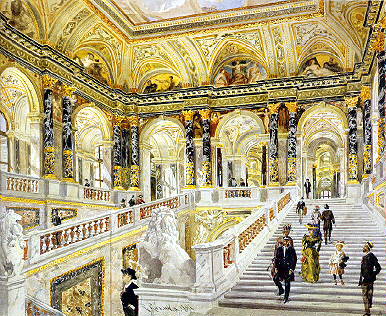 |
Whenever I escourt guests through this
museum I am fequently asked: "Who used to live in this palace?" This
is an excellent question because many large museums
of the world are former palaces, e.g. in the Louvre
in France or in the Prado in Spain. What is unique
about this museum is that it was built soley to house
an existing art collection.
Because it was built as a museum, the architects were able to calculate the height of the rooms in the picture gallery (first floor) to accommodate the large paintings of Rubens, and in particular to have space for things like the Egyptian collection in a room where the walls and the ceiling are painted to resemble the tomb of an Egyptian pharaoh.
|
|
Staircase: color painting by Robert Raschka, 1891 |
|
The court architect, Gottfried Semper, was responsible for
the design of the house, while his partner court-architect
Karl Hasenauer, made the plans for the interior. Both also
worked together at the Museum of Natural History, which is
like a twin of this museum. Within ten years, Semper completed
the museum, but it took ten more years to complete the interior
design.
The museum was opened in 1890 by Emperor Franz Joseph I Up to then, these collections were kept in various places such as in the Hofburg, the winter residence, or in the Lower Belvedere, which belonged at one time to Prince Eugen and later purchased by the Habsburgs. It took a long time, before this museum to be completed so that all the collections could be seen in one place
▲
Entrance
- The Pantheon of Art
|
Visitors are overwhelmed by the magnificent decorations
and the precious materials that one sees when entering
the museum. A classically cool, black and white marble
dominates the relatively dark area .
On the left and
on the right of the entrance stand low banks covered
with red leather. Sitting down, one automatically
looks upward, to the dome which is not closed. It has
a circular opening in its center.
Here, one is reminded of the Pantheon in Rome,
which was dedicated to the Roman Gods. This museum
is dedicated to the great artists, this is a Pantheon
of art. The shapes and forms of the dome are reflected
on the floor. This reflection of the grid on the
dome becomes a globe. A display of world power
is displayed here, depicting world domination of
the Habsburgs. |
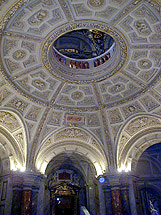 |
|
Marble Hall (Entrance) |
Marble Hall
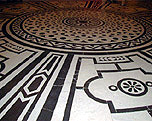 |
While real white marble from Carrara, Italy and red marble from Engelsberg, Austria dominates the hall, there is also artificial marble, called stuccolustro is covering the walls.
This artificial marble is mottled in white, green,
black, red, gray and yellow and was made by a famous
artist, the Italian, Antonio Detoma.
|
|
Floor of the marble-hall |
|
Guideance through the museum
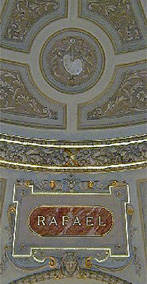 |
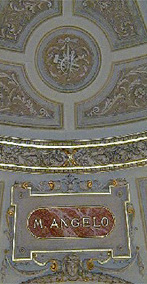 |
|
|
Raffael,
Painting gallery |
Michelangelo,
Antique collection |
Benvenuto Cellini,
Arts and crafts collection |
Bramante,
Architecture of the museum |
The dome gives us an introduction of what can be expected in this museum. Above the central stairs Rafael is displayed. Above it, in the circular field, is a painter's pallet and a brush: These stairs lead up into the second floor where the painters gallery is located. Above the stairs to the right M.angelo is written (Michelangelo). Above it, a sculptor's tool that depicts Micheleangelo's profession: These stairs lead up into the antique collection.
Above the left stairs we find Cellini's name. Above it, his gold blacksmith's tool. It stands as a representation of the arts and crafts collection that has been preserved in this area. Above the museum entrance one can see the signature Bramante's on red marble. Above it the symbols of an architect: A circle and right angle. It represents the architecture of the house.
|
Before we continue the tour, I want to point out that the cloakroom is just left of the entrance. Opposite the cloakroom the souvenir shop is located.
There are many books (also for children!),
miniatures of original objecs in excellent materials
and beautiful postcards of works of art that you may
want to buy.
To the
right of these stairs there is the information
desk called "Friends of the Museum",
which will gladly provide information. To the front
left, along side the central stairs, audio guides
may be rented.
|
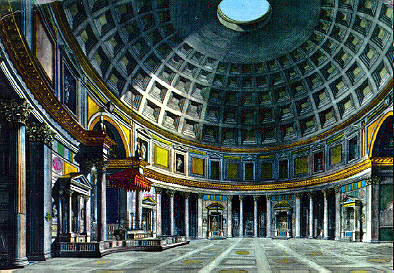 |
|
Pantheon in Rome |
On each side (behind the information desks) there are elevators for handicapped or tired guests. There are toilets next to the cloakroom, in the mezzanine, and on the first floor.
▲
The colorful
staircase
|
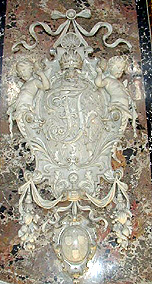
|
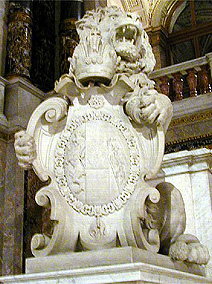 |
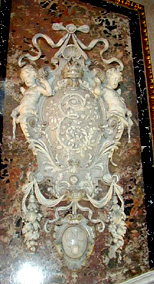
|
Initials of Emperor
Franz Joseph |
Lion with crest of arms |
Initials of Empress Elisabeth |
The Habsburgs as Maecenas (people
who support artists)
|
Leading up to the paintings is a broad and splended staircase made from dazzling white Carrara marble. Along the sides of the staircase there are plates, also made of white marble, promonently displaying the initials of emperor Franz Joseph I and his wife Elizabeth.
On the landings at the end of the stairs are two lions
with the coat of arms of the Habsburgs pinting out,
that they were the maecenas of this museum.
Imagine a building, owned for example by Shell Oil , where the company logo could be seen when coming or leaving the building. You would then know who are the benefactors of those priceless works of art.
|
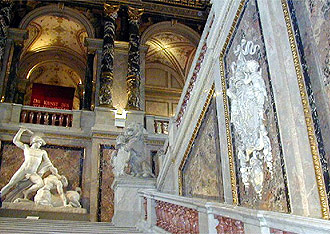 |
|
Staircase, Initials, Lion |
The marble sculpture "Theseus fights with the Centaur" is misplaced here!
|
The architect, Hasenauer, would turn over in his grave if he saw them there. This group of sculptures were made originally for the Theseus Temple in the public garden on the Ringsstrasse.
But in 1890, unfortunately, they were transferred to the newly erected museum. It was Napoleon who, in 1805 commissioned the most famous sculptor of the time, Antonio Canova, to create the group of marbles, called "Theseus fights with the Centaur".
It was intended to glorify Napoleon's victory
over the Austrians in the battle of Marengo in
1800. Napoleons' era was over, however, before
the works of art were completed. Canova looked
for a new customer and found it in Napoleons' father-in-law,
Emperor Franz II/I. The marble group was reinterpreted
as national monument commemorating the victory
over Napoleon. |
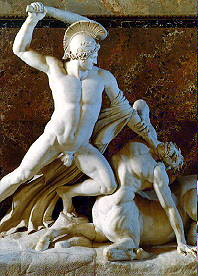 |
|
Theseus fights with the Centaur, 1819 |
|
As we proceed up the staircase, our eyes
take in the sumptuous colors. For the execution of
the paintings in the staircase, Hans Makart, the famous "Ringstraßen-artist" was
chosen. When he died, the job was transferred to the
brothers Ernst and Gustav Klimt and Franz Matsch.
These colleagues studied together and,
in 1879, founded an association of artists, which became
known as the "artists colony".
They worked together on a number of paintings
such as the ceiling paintings in the national theater
on the Ringstrasse, and made the interior decorations
in the Hermesvilla (hunting lodge of Empress Elizabeth).
The last work that the three of them did together was
the staircase here. |
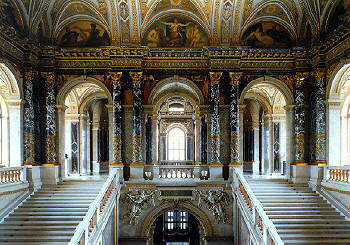 |
|
The colorful double-barreled
staircase |
▲
Ceiling
Painting: Apotheoses of Art
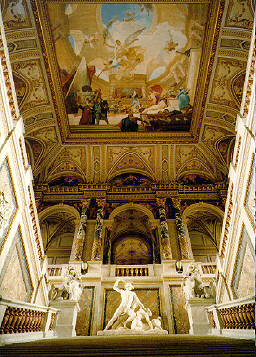 |
Look away from this broad and splendid Carrara marble
staircase for a moment and look instead behind it at
the flat, rectangular, unadorned surface. Your eyes
look up to the black and white columns and the paintings
that are hung between them. These represent the "History of Art".
Following the lateral beam of light and
looking further up, you can see the semi-circular paintings
above the columns. These lead to the highlight of the
staircase: the ceiling painting of "Apotheoses",
the glorification of art.
Now these grandiose views are almost
complete as they repeat themselves in the paintings
on the ceiling. One appears over the stairs in an artist's
studio.
The architecture here is the same
as in the staircase. Steps, double-coloums, and
from the open ceiling, symbolic figures are portraying
the fame and the honor of art.
From here, you
have the best view of the ceiling paintings. The
details of the paintings are posted on a plaque on
the first floor where they can be read comfortably.
|
|
Ceiling painting: Apotheoses of Art |
|
The Upper
Hall - The Hall of fame
After arriving on the first floor, visitors enter the upper dome hall. Just as in lower dome hall, one sees cool, elegant, black and white colors which are in contrast to the multicolored staircase and paintings used in the house.
This was done so that the dome would not compete
with the colorful paintings.
Today, this area contains a coffee house and a souvenir shop. From here we proceed to the Italian and Spanish paintings on one side and to the German and Dutch paintings on the other. This museum contains one of the largest collections of paintings by Rubens. It fills three halls.
Brueghles and Titians are also on display. The
works of French and English painters were rarely
bought by the Habsburgs.
|
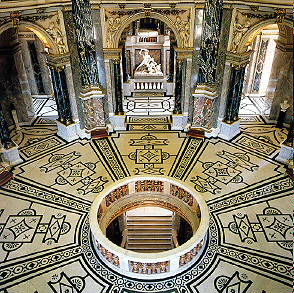 |
|
Floor design in the upper hall of fame |
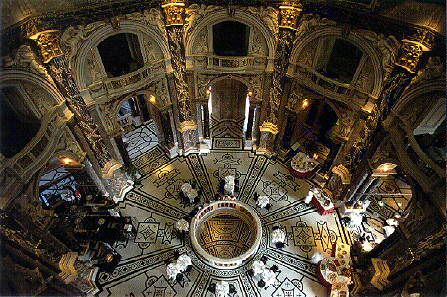 |
|
Upper Hall of Fame |
Accents in this hall are highlighted only by gold leaf
and by the red columns of the balustrade in the center,
around the central opening of the dome. Decorations of
rich figures dominate the area. |
The Habsburgs as maecenas
|
The glorification of the Habsburgs can be found again in their function as maecenas in the ceiling of the dome.
Eight of them, who were large collectors, are displayed
with their names, portraits and reliefs depicting all
their accomplishments.
An allegory of the portrait
medallions is displayed beneath the oval windows.
Below, in a row of broad relief, are the accomplishments
of each ruler along with his signature written on red
marble.
The statutes to the left and right of the
windows are holding the Habsburgs' crest of arms
and the initials of Empower Franz Joseph.
|
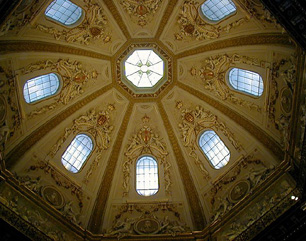 |
|
View looking up into the dome |
Emperor Franz Joseph I.
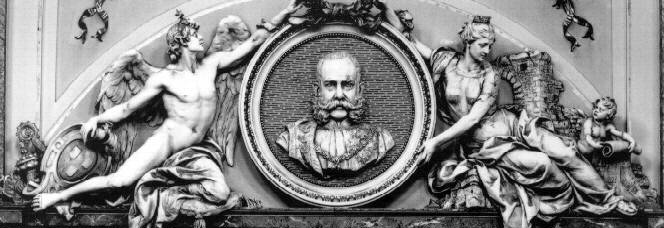 |
| Emperor Franz Joseph I. |
Emperor Franz Joseph is shown in his portrait wearing sideburns in the style of the 19th century.. The female figure on the left holds a medallion while one on the right wears a crown, symbolizing a personification of the city of Vienna, called Vindobona. In 1857, Emperor Franz Joseph orderred that the wall surrounding the city be torn down in order to build the "Ringstrasse" and the city extension.
 |
|
Emperor Franz Joseph and his acts |
Emperor Franz Joseph and his accomplishments are shown in a base relief under the portrait medallion. The emperor is shown in the center. Similar to the medallion above, he carries the medal chain of the Golden Fleece This time it is Vindobona who shows him the plan of the urban extension. He points his arm to the model of this museum. The little angel to the right holds the plan of the Ringstrabe and the city extension. The model of the museum has a double meaning. It honors the two geniuses behind it and Maria Theresa. The other honors a painter with his pallet in his hand. Here, the architecture, the paintings and sculptures are all united. The arts shown in this museum are very heavily promoted.
In the left corner of the museum is the statue of a bound Danubius symbolizing all of the Danube regulations. The statue to the right is a nymph with a water jug in hand and a man refreshing himself from the water. This symbolizes the Viennese water pipeline and its source in the mountains south of Vienna. It was ordered to be built by Emperor Franz Joseph.
|
|
|